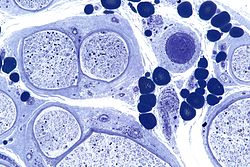Peripheral neuropathy
| Peripheral neuropathy | |
|---|---|
 | |
| Micrograph wey dey show a vasculitic peripheral neuropathy; plastic embedded; Toluidine blue stain | |
| Specialty | Neurology |
| Symptoms | Sensory: Numbness, neuropathic pain, poor balance Motor: Muscle weakness, twitching, muscle shinking Autonomic: Trouble plus heat, excess sweating, trouble swallowing |
| Causes | Diabetic neuropathy, alcoholic neuropathy, Guillain-Barré syndrome, carpal tunnel syndrome, meralgia paresthetica, complex regional pain syndrome, injury, poor blood flow, autoimmune, kidney anaa liver problems, vitamin B12 deficiency, paraneoplastic syndromes, certain medications wey dey include chemotherapy, genetic disorder|genetics, shingles, Lyme disease, HIV/AIDS, unclear |
| Diagnostic method | Based for symptoms, examination, den blood tests |
| Treatment | Based on underlying cause, nortriptyline, duloxetine, gabapentin |
| Frequency | 1 to 7% of people |
Peripheral neuropathy, dem often shorten to neuropathy, dey refer to damage anaa disease wey dey affect de nerves.[1] Damage to nerves fi impair sensation, movement, gland function, den/anaa organ function wey dey depend on wich nerve fibers be affected. Neuropathies wey dey affect motor, sensory, anaa autonomic nerve fibers dey result insyd different symptoms. More dan one type of fiber fi be affected simultaneously. Peripheral neuropathy fi be acute (plus sudden onset, rapid progress) anaa chronic (symptoms dey begin subtly den dey progress slowly), wey fi be reversible anaa permanent.
Common causes dey include systemic diseases (such as diabetes anaa leprosy), hyperglycemia-induced glycation,[2][3][4] vitamin deficiency, medication (e.g., chemotherapy, anaa commonly prescribed antibiotics wey dey include metronidazole den de fluoroquinolone class of antibiotics (such as ciprofloxacin, levofloxacin, moxifloxacin)), traumatic injury, ischemia, radiation therapy, excessive alcohol consumption, immune system disease, celiac disease, non-celiac gluten sensitivity, anaa viral infection. E sanso fi be genetic (present from birth) anaa idiopathic (dem no know de cause).[5][6][7][8] Insyd conventional medical usage, de word neuropathy (neuro-, "nervous system" den -pathy, "disease of")[9] widout modifier usually dey mean peripheral neuropathy.
Neuropathy wey dey affect just one nerve be called "mononeuropathy", den neuropathy wey dey involve nerves insyd roughly de same areas for both sides of de body be called "symmetrical polyneuropathy" anaa simply "polyneuropathy". Wen two anaa more (typically just a few, buh sam times chaw) separate nerves insyd disparate areas of de body be affected e be called "mononeuritis multiplex", "multifocal mononeuropathy", anaa "multiple mononeuropathy".[5][6][7]
Neuropathy fi cause painful cramps, fasciculations (fine muscle twitching), muscle loss, bone degeneration, den changes insyd de skin, hair, den nails. Additionally, motor neuropathy fi cause impaired balance den coordination anaa, most commonly, muscle weakness; sensory neuropathy fi cause numbness to touch den vibration, reduced position sense wey dey cause poorer coordination den balance, reduced sensitivity to temperature change den pain, spontaneous tingling anaa burning pain, anaa allodynia (pain from normally nonpainful stimuli, such as light touch); den autonomic neuropathy fi produce diverse symptoms, wey dey depend on de affected glands den organs, buh common symptoms be poor bladder control, abnormal blood pressure anaa heart rate, den reduced ability to sweat normally.[5][6][7]
References
[edit | edit source]- ↑ Kaur, Jaskirat; Ghosh, Shampa; Sahani, Asish Kumar; Sinha, Jitendra Kumar (November 2020). "Mental Imagery as a Rehabilitative Therapy for Neuropathic Pain in People With Spinal Cord Injury: A Randomized Controlled Trial". Neurorehabilitation and Neural Repair. 34 (11): 1038–1049. doi:10.1177/1545968320962498. PMID 33040678. S2CID 222300017.
- ↑ Sugimoto K, Yasujima M, Yagihashi S (2008). "Role of advanced glycation end products in diabetic neuropathy". Current Pharmaceutical Design. 14 (10): 953–61. doi:10.2174/138161208784139774. PMID 18473845.
- ↑ Singh VP, Bali A, Singh N, Jaggi AS (February 2014). "Advanced glycation end products and diabetic complications". The Korean Journal of Physiology & Pharmacology. 18 (1): 1–14. doi:10.4196/kjpp.2014.18.1.1. PMC 3951818. PMID 24634591.
- ↑ Jack M, Wright D (May 2012). "Role of advanced glycation endproducts and glyoxalase I in diabetic peripheral sensory neuropathy". Translational Research. 159 (5): 355–65. doi:10.1016/j.trsl.2011.12.004. PMC 3329218. PMID 22500508.
- ↑ 5.0 5.1 5.2 Hughes RA (February 2002). "Peripheral neuropathy". BMJ. 324 (7335): 466–9. doi:10.1136/bmj.324.7335.466. PMC 1122393. PMID 11859051.
- ↑ 6.0 6.1 6.2 Torpy JM, Kincaid JL, Glass RM (April 2010). "JAMA patient page. Peripheral neuropathy". JAMA. 303 (15): 1556. doi:10.1001/jama.303.15.1556. PMID 20407067.
- ↑ 7.0 7.1 7.2 "Peripheral neuropathy fact sheet". National Institute of Neurological Disorders and Stroke. 19 September 2012. Archived from the original on 4 January 2016.
- ↑ Zis P, Hadjivassiliou M (February 2019). "Treatment of Neurological Manifestations of Gluten Sensitivity and Coeliac Disease". Current Treatment Options in Neurology (Review). 21 (3): 10. doi:10.1007/s11940-019-0552-7. PMID 30806821. S2CID 73466457.
- ↑ "neuropathy". Online Etymology Dictionary.
Read further
[edit | edit source]- Latov, Norman (2007). Peripheral Neuropathy: When the Numbness, Weakness, and Pain Won't Stop. New York: American Academy of Neurology Press Demos Medical. ISBN 978-1-932603-59-0.
- "Practice advisory for the prevention of perioperative peripheral neuropathies: a report by the American Society of Anesthesiologists Task Force on Prevention of Perioperative Peripheral Neuropathies". Anesthesiology. 92 (4): 1168–82. April 2000. doi:10.1097/00000542-200004000-00036. PMID 10754638.
External links
[edit | edit source]- Peripheral Neuropathy from the US NIH
- Peripheral Neuropathy at the Mayo Clinic
